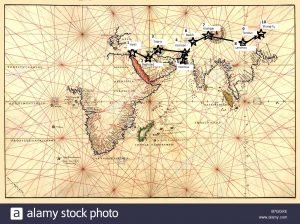When Marco Polo journeys through India, he speaks of the kingdom, Quilon. The kingdom is located 500 miles south-west in relation to Maabar.
Marco Polo introduces this province saying the people are mainly idolaters with the exception of a few Jews and Christians. He says the people have their own language and answer to a king who is subordinate to no one. From previous passages, it is clear that Marco Polo uses the term “idolaters” derogatively to show that their religion opposes Christian ideals. He makes a point to include that Jews and Christians are among the people to show there were other religious groups aside from idolaters.
Next, Marco Polo speaks of the province’s produce. He says they harvest large amounts of pepper and Quilon brazil. He says that pepper is specifically grown in the months of May through July. Marco Polo also mentions the growth of indigo how it is specifically produced. He additionally he mentions the hot climate and expresses the extensiveness of it saying if one were to put in an egg in one of the rivers, the egg would boil. He then mentions how this territory thrives in trade because of the exchange of goods from the following countries: Arabia, Manzi, and the Levant. The countries are able to trade by sea. Marco Polo almost always mentions trade given that he is a professional trader.
In Marco Polo’s description of these goods, he expresses how these crops are produced in detail. It is evident that he is trying to show Western Europeans how different their crops, as well as their methods, are in producing these goods. He mentions the months in which pepper is grown and goes into the specifics of how Indigo is produced. Indigo was a rare commodity in Western Europe so it would have been fascinating to Western audiences in learning how it was made. In addition, he exaggerates the hot temperatures which can be assumed that the rivers did not reach boiling temperatures. This was most likely used to once again captivate his targeted European audience.
Marco Polo also focuses on the variety of beasts. He mentions black lions, parrots that differ in color and size, peacocks, and hens. He then emphasizes how unique these animals are from the ones he has seen in Western Europe and even from “those of all the rest in the world.” He emphasizes on their grandness and difference from everywhere else which can be assumed that he was trying to relate enchanting information back to Western Europe. In addition, he also expresses the difference in their fruit that is due to the land’s hot climate. He speaks of their wine and how it has uses sugar causing the people to be intoxicated faster in comparison to grape wine. This comparison to grape wine is telling that he views the wine Europeans drink to be better since it does not make people as intoxicated which was seen as improper and undesirable. He then makes a point to speak of Quilon’s good physicians who keep their people in good health which is important for audiences to know if they do wish to travel given that sickness and rise in death tolls were prevalent.
Lastly, Marco Polo discusses the appearance of the people of Quilon in how they dark-skinned and dress almost naked with a piece of loincloth. Similar to other travel passages, Marco Polo makes a point to describe their unique dress; however, he does not express this with as much disdain in his previous passages which shows maturity in sharing information about other people’s’ cultures. On the contrary, he expresses disapproval for the how the people face no religious repercussions for engaging in sexual actions. His dislike is clear since he expects there to be some sort of punishment for this kind of action most likely having to do with his Christian views. He also says that is customary for men to marry his father’s widow, cousin, or his brother’s wife. He says that this was a commonly seen throughout the Indies. He seems to be saying this as if it were something new and only occurred within in the Indies, but from other travel narratives, this practice seems to be universal. It is inconclusive as to why he would find this to be unique.
In this passage, it is clear that Marco Polo chose to focus more on the animals and goods in Quilon. It can be interpreted that he is drawn to these specific aspects since they dramatize the vast difference in climate and vegetation. Since Marco Polo aims to captivate Western Europeans, it would make sense that he would want to focus on the things that would make this specific territory standout and be as memorable as possible.
